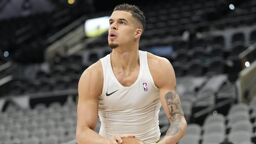At this time last year, then-University of Pennsylvania swimmer Lia Thomas had become a national story. A couple weeks before, she put up the nation’s-best times in various freestyle swimming events at an otherwise obscure invitational meet at the University of Akron.
Iszac Henig was at the time unknown to most, but quite valuable in the eyes of his Yale women’s swimming teammates. He had chosen to hold off starting hormone replacement therapy after coming out as a transgender man in 2021, because he wanted one last ride for an Ivy League championship with the teammates who supported him.
“I value my contributions to the team and recognize that my boyhood doesn’t hinge on whether there’s more or less testosterone running through my veins,” he stated in a Pride Month article in the New York Times last June. “At least, that’s what I’ll try to remember when I put on the women’s swimsuit for competition and am reminded of a self I no longer feel attached to.”
The ripples of their success last season extended far beyond the swimming pool and in many ways defined the growing debate surrounding inclusion. Their exploits in competition and how those affect sports as a whole are what make both Thomas and Henig Outsports Transgender Athletes of the Year for 2022.

They became linked at a twin-dual meet between their schools and Princeton in January at Penn. They met head-to-head in the 100-yard freestyle. Henig won. Thomas was sixth.
After the meet, the Penn and Yale seniors gathered for a picture. The meet would be Thomas’ last at Penn.
The two transgender student-athletes stood next to each other not knowing how linked they would be going forward.
Since putting up NCAA automatic qualifying marks in the 200 and 500, Thomas was a hot topic. Much of the discussion came from those who saw her as someone who would “destroy women’s sports”.
Varied pundits, certain women’s sports advocates, and traditionally anti-LGBTQ lobbies tried to paint her a monster who would crush the sport. The fear of her rise may have been the catalyst of the NCAA, USA Swimming and, later in the year, FINA to make sweeping changes in regard to regulations for transgender women in women’s swimming.
Thomas would say little and swim fast. She gave four interviews the entire season, even when the NCAA was sending mixed messages with the championships looming. She handled things with a quiet grace, even amid the internet boo-birds and members of her own team claiming they were “silenced” while anonymously squawking to any anti-trans media who would listen.
When she did speak, she told the story of someone seeking happiness within themselves. Swimming was a part of that happiness, and it was melded with her finding her truth and her transition.
“I did HRT knowing and accepting I might not swim again,” she said to Sports Illustrated’s Robert Sanchez in one of the few interviews she’s granted. “I was just trying to live my life.”
“It surprised me,” Thomas continued. “I felt, mentally, a lot better and healthier pretty quickly. The relief it gave me was quite substantial.”

Over two years after starting her transition, she was in the starting blocks at the Ivy League championship meet. She won three individual titles, was the part of a winning relay and combined with Henig to make more history.
The 100-yard freestyle final came down to these two unlikely newsmakers in a rematch of their tilt at Penn. Henig had made his own history by snagging the conference title in the 50-yard freestyle sprint.
This time, Thomas got the better of the engagement in a close race. It was it the first time you had two transgender athletes fighting in a Division I conference final and they finished one-two.

A month later both were in Atlanta for the NCAA Division I championships and each made their mark. Henig earned All-America honors for a fifth-place effort in the 100 freestyle, and he earned praise for a makeshift tattoo on his arm that was noticed by more than few cameras. It read “Let trans kids play”.
Thomas put her name in the record book for all time in the 500-yard freestyle. She outraced three U.S. Olympians to become the first transgender student-athlete to take home a national championship in NCAA Division I. It was her only national title, but she ended the meet with All-American designation in her two other individual events.

The meet ended, but conjecture continued in the regulatory, and even political, landscape since. Her name was regularly mentioned by some running for office in the U.S. midterm elections.
The International Swim Federation went forward with new regulations that effectively ended hopes of seeing Thomas competing at the Paris Olympics in 2024. Other Olympic sports, such as cycling, have changed or are in the process of changing their regulations as well. Even a sport such as disc golf instituted similar policy changes on fears of a successful transgender woman “dominating”. Much of that fear comes from the discussion over a swimmer from Penn who had a great year.

For the main characters of this tale the recent past seems far away.
“The best moment for me is coming home from a long day of school and swimming and not worrying about how people react,” Thomas said to ESPN’s Katie Barnes in a interview in June. “I’m feeling at peace with who I am.”
The national champion is pursuing a different goal as a first-year law student at Drexel. Thomas said she has ambitions to pursue civil rights law.
Henig, who told the Hartford Courant last season, “I’m just some dude who gets to play his sport at a really cool level. I’m just here to go fast and have a good time,” is back in competition. He is a member of the men’s swimming team at Yale.
Each has moved forward with their lives even as the debate surrounding last season continues.
Both would probably agree with Thomas’ answer to Barnes on a follow-up in that June interview on whether it was all worth it.
“I would say yes,” she replied. “I was able to do the sport that I love as my authentic self.”
Previous Outsports Trans Athlete of the Year Award winners:
2021: Alana McLaughlin
2020: Lindsay Hecox







































